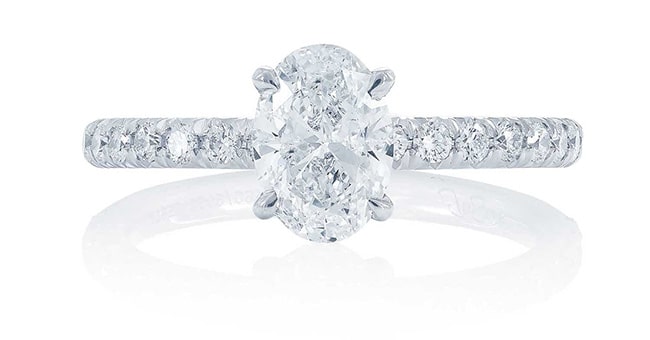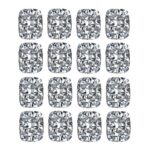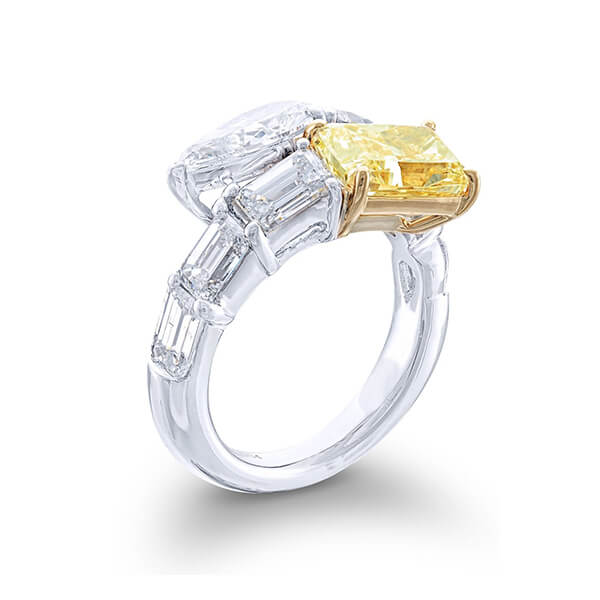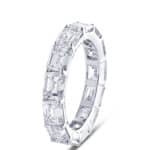Tension Set Diamond Engagement Rings – The Complete Guide
Those looking for an engagement ring that stands out from the norm, come across the allure and trendiness of tension set engagement rings. While their elegance and captivating features are unquestionable, there are more questions than answers.
In this guide, we’ll go through what makes Tensions Set Rings so unique, how to choose the perfect ones, their pros and cons, and most importantly, elaborate on their safety and longevity. So let’s begin, shall we?
What Are Tension Set Diamond Engagement Rings?

Whereas the majority of the classic engagement rings implement prongs or bezel settings to secure the center diamond in place, Tension Settings use Tensile Force and the laws of physics as a method of holding the diamond in place, giving the illusion of miraculously floating in mid-air without anything diminishing the complete view of the diamond, and with intricate and beautiful metal band designs.
While the concept and attempts of implementing tension settings started over half a century ago, the results were sub-par, looking too chunky, and not as safe as one would hope for. Luckily, with technological advancements, and using lasers to pinpoint the exact dimensions to support the center diamond, Tension settings, which were years ahead of their time, are now able to present a modern and sleek style that is increasing in popularity.
How Do Tension Set Rings Work?
Just like any good magic trick, there’s a sophisticated logical reason behind the illusion. In order to give the visual appearance of behind held by thin air, tension rings are designed in such a way where it has a small yet perfectly accurate opening to surround and hold the center diamond using pressure.
Why Go For a Tension Set Engagement Ring?
- The appeal of the tension set ring designs is unquestionable. Many upcoming newlyweds find the common, although classic in their own right designs, to be somewhat tired and want an engagement ring that will make a statement and even start a conversation. The mystic of the floating appearance of the tension ring, as well as its sophisticated surrounding band designs, make it a tremendous idea for an engagement ring.
- One of the undeniable benefits that Tension Settings bring to the table is that they allow the center diamond to be proudly displayed in full view, compared to classic prongs or bezel settings that in order to provide security do cost some visibility. Comparatively, Tension Rings allow for more light to be displayed and maximize the sparkle the chosen diamond carries.
- Tension Set Rings are easier to clean and maintain as they don’t have any nooks and crannies that build up dirt.
- They are versatile and can be customized to the highest extent. Since many of the tension set engagement rings are relatively thick, the selections are suitable for both men and women and work well with a variety of diamond cuts and precious metals.
What are some of the cons of opting for a Tension Set Engagement Ring?
- They are more expensive than some of their classic distant relatives. Why? Because in order for them to keep the center diamond in place, customer laser modifications must be made to the metal band to cater to the specific diamond of your choice.
- Tension rings cannot be resized without significant damage to their customize settings. After all, they were created with pin point accuracy in mind, in order to provide a safe haven for the center diamond and its exact dimensions according to the ring’s original features. As a result, Tension Set Engagement Rings have to be completely remade if resizing is required.
- Center diamonds may appear relatively smaller when compared to some of the more thin and minimal bands used in classic engagement rings.
Are Tension Set Rings Safe?
While the floating illusion of the tension settings may bring some initial concerns, as long as you opt for legitimate and established jewelry craftsmen and companies, tension settings are very safe. Why? Because they are laser calibrated to perfected, and tensile force is enforcing them on both sides. As an added safety measure, subtle, yet highly effective grooves are cut into the metal to further aid to keep the diamond in place.
While not completely impossible for the stone to be damaged or lose its placing, the amount of sheer concentrated force required to do so puts it at a nearly impossible, and not a reason for concern.
What Are Faux Tension Rings or Tension Style Rings?
As the name would suggest, Faux Tension Rings do not go by the rules of a true Tension Engagement Ring which is hand made and laser calibrated to use force as a means of keeping the diamond in place. Instead, in Faux Tension Rings there is a tiny metal bridge that keeps the stone in place, mimicking the floating effect of the original tension ring. They do not need to be hand made, and often aren’t, instead, they are mass-produced. The result is a less costly tension style, with added security, but with some diminished quality, uniqueness, and authenticity.
Best Metals for Tension Set Engagement Rings
The quality of metal and its ability to withstand and support the force of the diamond is an incredibly important factor. Of course, beauty is also important from the customer’s point of view. While Titanium is at the top when it comes to pure strength and durability, White gold is the most popular choice as a balance between beauty and strength. Other popular options include Palladium, Rose Gold, and Yellow Gold, but are made thicker in order to compensate in strength factors.
Tension Ring Settings and Design Styles
While the principle behind achieving the tension ring settings remains the same, the unique designs and combinations that are used are incredibly rich, with each having its own allure.
Classic Tension Set Engagement Rings
Minimalist style yet incredibly stunning. The classic tension ring incorporates tensile force met by the two halves of the ring, which is ideal for a modern touch of solitaire rings.
Bypass Tension Set Engagement Rings
Whereas the traditional tension set ring has the two halves of the rings meet the diamond in the middle, Bypass settings which were first introduced during the victorian era actually overlap one another at a 90 degree right angle and meet each other perpendicularly, compared to the classic parallel method.
Tension Bar Set Rings
Similar to the classic rendition of the tension method, Bar sets differ at the point of connecting with the center diamond. Instead of the sides of the band simply connecting to it, two metal bars provide its support as well as elevation while facing forwards instead of inwards. Creating a stunning frame of sorts.
Split Shank Tension Set Rings
Popular in their own right due to their incredible unique look, split shank designed rings can also be combined with the tension concept. The shank of the ring is split into two parts which create two separate, and at the same time, eventually connected two pieces of metals. Instead of connected and implementing tensile force in the old fashioned way, the split shank does so by supporting each side of the center diamond, and the result is visually stunning.
Tension Rings with Pavé Settings
Another variation on the classic tension set is combining it with pave diamonds. A group of smaller, even melee sized diamonds strategically placed on the sides surrounding the ring and providing further embellishment.
Are Tension Set Rings Safe?
While the floating illusion of the tension settings may bring some initial concerns, as long as you opt for legitimate and established jewelry craftsmen and companies, tension settings are very safe. Why? Because they are laser calibrated to perfected, and tensile force is enforcing them on both sides. As an added safety measure, subtle, yet highly effective grooves are cut into the metal to further aid to keep the diamond in place.
While not completely impossible for the stone to be damaged or lose its place, the amount of sheer concentrated force required to do so puts it at a nearly impossible, and not a reason for concern.






